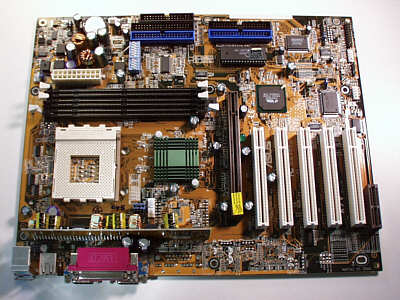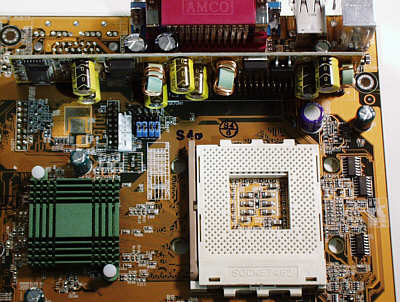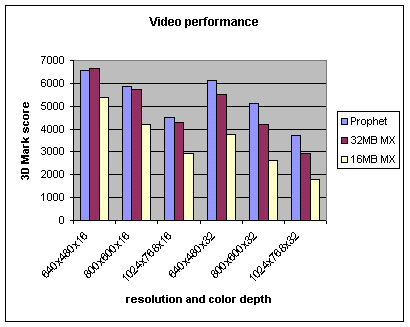
The Asus A7V was the first Socket-A
motherboard we were able to get a hold of and test. But now others,
such as the Abit KT7-RAID, are out as well, so I decided to take a look at
both boards, starting with the A7V. The Asus A7V is a Socket-A
format (socket 462) motherboard, made for AMD "Thunderbird"-type Athlon processors,
and the new AMD Duron processor. The A7V is a full-sized ATX motherboard, so
make sure the case you are using will take a full-size board.
Introduction: The A7V is a well made board with an unusual addition not found on
many motherboards. It's got an additional power board mounted at
right angles to the mainboard, which you can see in the picture below.

When I review motherboards, I don't spend
much time doing benchmarks, because the benchmarks between motherboards
are usually very close. I'm much more interested in things like
layout of components, selection of features, ease of installation and
setup, and especially stability.
The layout of the board is acceptable, but
as with most Socket-A motherboards, the placement of components near the
catches for the heat sink clips makes attachment of the heat sink a risky endeavor.
One slip with a pliers while trying to hook the spring clip on the catch,
and you could gouge the motherboard surface. Having components in the
way makes getting to the clips difficult. It's an arrangement we
think needs reworking.
Also, the placement of DIMM sockets and the
additional power board near the CPU socket means that you may have
problems attaching large heat sink and fan units, such as the Golden Orb.
There is plenty of room to the left and right of the socket, but the
catches for the heat sink are above and below the socket, where components
get in the way.
Features:
The Asus A7V has some nice features, including ATA-100 support with the
new Promise controller chip. It also sports an AGP-Pro slot. Here's what Asus has to say about the A7V:
 |
Supports
AMD® ThunderbirdTM / DuronTM
550MHz ~ 1GHz CPU. |
 |
3x DIMM
support for 1.5GB PC133/PC100/VCM133 SDRAM. |
 |
New PCI
v2.2 and USB v1.1 standards |
 |
Ultra
DMA/100 and DMA/66 support |
 |
5 x PCI and
1 x AMR |
 |
Up to 7 USB
Ports max. |
 |
200MHz
Front Side Bus |
 |
Stepless
Frequency Selection |
 |
PC Health
Monitoring |
The inclusion of PCI 2.2 and USB 1.1 standards is nice.
The A7V motherboard is based on VIA's new KT133
chipset, which supports Thunderbird and Duron processors in the Socket-A
format. The board has the 5 PCI plus 1 audio modem riser
configuration of peripheral slots, rather than the preferred 6 PCI slot
layout. The board does have an AGP-Pro socket though, which will be
helpful for folks thinking about an AGP Pro card for their system. And while the A7V
has 4 built-in fan connectors, none of them is located near the bottom of
the board for the front case fan.
The worst design feature on the A7V is the
"Clear CMOS" jumper. The reason it is so bad, is that
there is no jumper! There are just two solder joints on the board,
and you need to find a U-shaped piece of metal which you can use to short
out those two solder joints. It's not only a pain, it is difficult and downright
irritating. Overclockers want an easy and quick method of clearing the
CMOS, if necessary, and don't want to hunt around for a bent piece of metal
(I used tweezers).
Setup and Testing: I
tested the A7V (revision 1.02) with an Athlon 800MHz processor and 128MB
of PC-133 SDRAM. I used an Asus V7100 32MB MX video card with
Detonator-2 version 5.30 drivers, and 3D Mark 2000 version 1.1 for
stability testing.
Except for the potential risk when clamping the
heat sink clips, installation was easy. On first bootup, I was very
surprised by the length of time required for the system to boot. At first,
I thought there might be a problem, but it eventually booted normally.
While booting off of an ATA66 drive with Windows
98SE installed, and without
any ATA100 drives attached, the cold boot time varied between 2 minutes 20 seconds and
2 minutes 40 seconds! This is the longest boot time we have ever
recorded for an IDE motherboard.
The Promise controller looked for ATA100
drives for several seconds, so I attached an ATA/100 drive to one
controller. This cut the boot time by about 30 seconds, but the boot
time still remained in the 2 minute range. Just to be sure it wasn't
a bad board, I tried a second A7V board, which exhibited the same slow
boot behavior. In comparison, an Abit
KT7-RAID motherboard with the same CPU and hard drive only took about 50 to 60 seconds to
boot. I will do a comparison of the Promise ATA/100 controller on
Asus boards with the ATA/100 controller from HighPoint on Abit boards in
another review.
Shutdown times were another story
altogether. The average Win98SE shutdown time for the A7V was a very
respectable 3 seconds. However, fast shutdown times on new systems
can actually be a problem. There is a known bug in both Win98 SE and Win
ME on computers running at 933MHz or faster. For more information on the
Windows shutdown bug, go here.
The graph below shows the Direct 3D
performance with several popular GeForce cards on the A7V. I used
the Detonator-2 5.30 drivers, and 3D Mark 2000. The scores are for a
Hercules 3D Prophet-1 32MB DDR card, an Asus V7100 32MB MX card, and an
Asus V7100 16MB MX card.

Bus Overclocking:
Overclocking the A7V is easy due to the jumper-less design, and the board is quite stable at overclocked
speeds. A nice addition to Asus boards is the so-called V I/O jumper,
which regulates the power level to the peripheral slots. This can be
helpful when overclocking the AGP slot, for example. But on the A7V,
when I moved the jumper from it's normal position at 3.56 volts, to 3.69
volts, the voltage warning alarm sounded on rebooting. This alarm can be
disabled in the BIOS, but the warning alarm should have been pre-set above
3.7 volts to avoid this problem.
I began overclocking the T-bird 800
processor with the core voltage set to 1.6 volts (default). I
increased the bus frequency in the BIOS in steps, to see how far it would
overclock before failing. The graph below shows how the testing
went.

The system failed at 113MHz, and
failed again at 113MHz with the core voltage boosted to 1.7 volts. At
111MHz on the bus (888MHz total processor speed), the system ran 3D Mark
2K continuously for hours at the default core voltage. The A7V also
overclocked a Duron 650 to 111MHz (722MHz total) with complete stability
at the default core voltage (1.5v). Getting Athlons and Durons to
run stably at 111MHz is about as good as you can expect.
Multiplier Overclocking:
Asus outdid themselves when they decided to add the ability to change the
CPU multiplier setting on the A7V. We had been worried that bus
overclocking would be all we could get with the new T-Birds and Durons.
But Asus added the ability to change the multiplier right on the
motherboard. The only problem is, they did not put the options in
the BIOS setup. So you need to do all the settings for overclocking
with the DIP switches on the board. While this is quite inconvenient
compared with Softmenu III on the KT7-RAID board, at least the option for
multiplier overclocking is there. We were able to run the 800MHz
T-bird at 9.5x 100 = 950MHz at 1.7volts on the core. We also were
able to run the Duron 650 at 800MHz, with a core voltage of 1.65v.
Summary:
As motherboards go, the A7V is a well rounded product. There are a
few design goof-ups in my opinion, but overall, the A7V is a good socket-A
motherboard. It compares acceptably with high-profile boards like
the Abit KT7-RAID motherboard, but falls slightly short of that
mark. The lack of IDE RAID capabilities, despite the inclusion of
the Promise ATA-100 controller, is a shortcoming. The long boot time can
be frustrating while setting up a system, where frequent reboots are
necessary. The lack of a convenient way of clearing the CMOS can be
frustrating if you are overclocking the system.
The good points include a solid, stable
platform for overclocking Thunderbird and Duron processors, good ATA/100
support, an AGP Pro socket, jumperless setup, and support for up to 7 USB
ports. The A7V boards I tested overclocked both T-bird and Duron processors to just
as high a level as the Abit KT7-RAID, which means that stability is
excellent. However, there are only a few features on the A7V that are not present
on the KT7-RAID from Abit: for example, the AGP Pro slot. The KT7-RAID has
a standard AGP slot. So if RAID capabilities are not important to you, but
an AGP-Pro slot is, the A7V may be the T-bird/Duron motherboard for you.
If you think you might want to try a RAID array, go for the KT7 from Abit.
Pros:
- Good stability and overclocking
capabilities
- Multiplier overclocking on board
- ATA-100 drive support
- AGP Pro socket
- First Socket-A processor motherboard to
market
- Up to 7 USB ports
- Nice BIOS features
- PCI 2.2 and USB 1.1 standards
- Jumperless setup
- Good manual
|
Cons:
- Only 5 PCI slots
- Audio modem riser slot not needed
- Multiplier settings not in BIOS
- No Clear CMOS jumper
- Very long boot time
- No IDE RAID support
- Difficult access to heat sink catches
Price:
Approximately $160 US
Rating, : 4.3
smiley faces (86%, B+)
:) :) :) :) +
Availability:
Good
|
Copyright September 28th, 2000 |